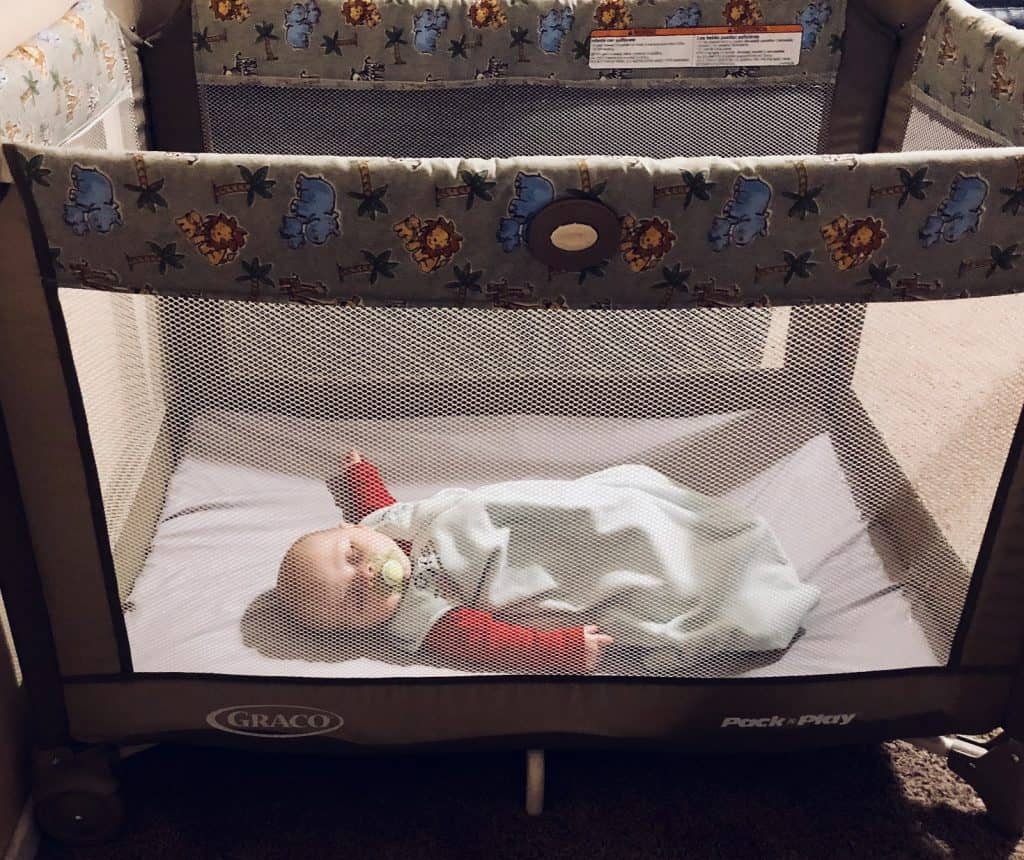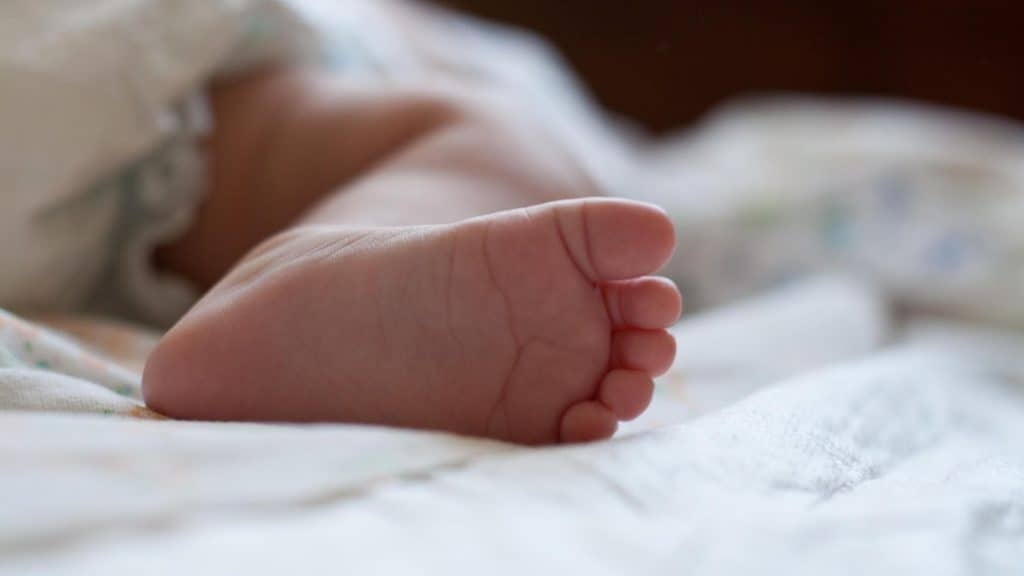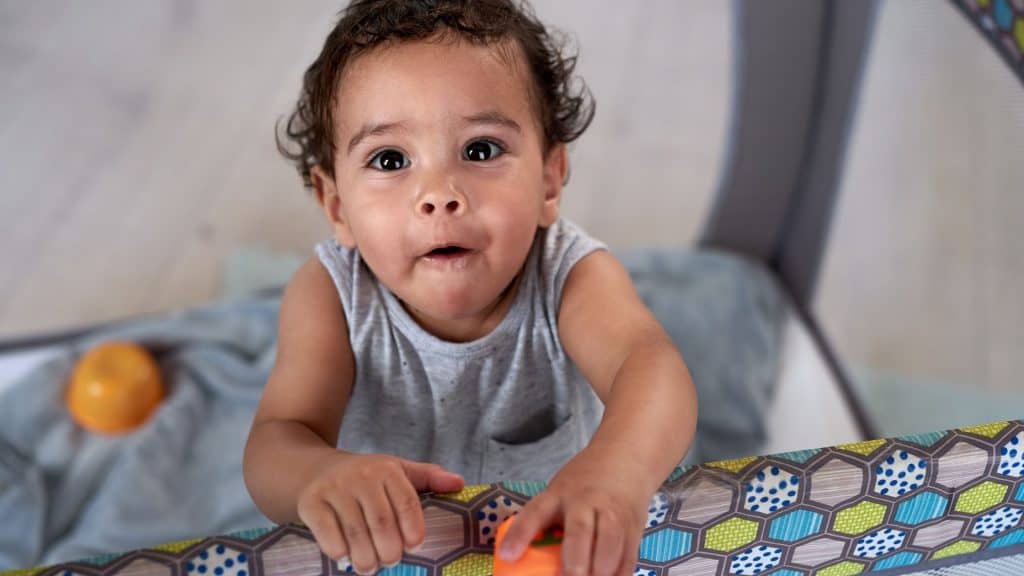This is a “bitter” fact that most parents will relate to – if you’re wondering if a baby can sleep somewhere, the answer is probably no.

The good news is that a pack n play is an exemption to that rule. If you use it safely, it’s OK for your baby to sleep in a pack and play. Most experts will agree on that, and it’s the official position of the AAP American Academy of Pediatrics.
Today, I’ll offer some handy tips on how to put your little one to sleep in a pack n play, along with some safety guidelines.
Putting your baby to sleep in a pack n play
Most of the tips I’ll go over below also ring true for a general away-from-home scenario.
Introduce them to sleeping away from home early on
Sleeping in a pack n play for the first time will likely be out of their comfort zone, and it won’t be perfect.
That’s fine.
If you’re planning a trip, schedule some in-house exercises and give them a chance to adapt to the portable crib or playard in the safety of your home.
Have an active day before sleeping in a playard
If you’re introducing a new sleep environment, your chances of doing it successfully skyrocket if the baby has an active day before.
Keep the ritual
If you already have a bedtime routine, stick to it as you put them to sleep in a pack n play. Keeping the chain of events unchanged will trigger the ‘it’s-bedtime’ signal in their heads.
If they’re tired on top of it, they doze off in no time.
Mimic the original environment
If your baby sleeps in a smart crib that plays soothing sounds, installing an app and playing the same sounds, white noise, or music will go a long way.
To take it one step further, bring the same sheets and blankie you typically use.
Keep them in the dark
For daily naps, use a darkening tent/canopy or shades to keep the room dark. I know some parents believe in napping in the light, but that never worked for us. A dark, quiet room will be the way to go for most babies.
At night, avoid exposing them to bright light for a few hours before bedtime. Light exposure before sleep interferes with the Melatonin levels, and if you combine that with a changing environment, you’re in for one long night.
I have a complete guide on making a pack n play dark enough for sleep – you can see it here, and you can see the guide on best travel pack n plays here.
Other related reads: Co-sleeper vs. pack n play | pack n play vs. crib | travel crib vs. pack n play | bassinet vs. pack n play
Making the pack n play safe for sleep
A pack n play is generally already safe for sleep, and the main risks come from the things parents add or change as they try to make the playpen more comfortable.
Sleeping in a playard is not about comfort, and it’s probably not going to be as calm or refreshing for them until they get used to it. Again, that’s fine because safety takes precedence over comfort.

So, forget about adding any extra blankets, toys, or pillows.
However, there still are things you can do – I have a separate guide on making a Pack n play more comfortable here.
Finally, some of the modern pack n plays come with a bassinet attachment – those are diaper changes. That’s it. Don’t leave them unsupervised or let them fall asleep in it – they are much more likely to roll over if you do.
Safety precautions of sleeping in a pack and play
You’ll probably know some of these since they share a lot with general safety sleep guidelines. Most of them, however, are specific to playpen safety.
Don’t leave the mesh sides down
The mesh sides should be up at all times, especially during sleep. Loose, rolled-down mesh is a suffocation risk.
Know when to get rid of the pack n play toys
As soon as your baby can sit upright or crawl on all fours, get rid of any toys from the top edge. As a rule of thumb – anything they can grab is an entanglement risk.
Remove the changing table
If you have a playpen with a changing table, remove the table when you’re not using it.
If you leave it attached, there’s a risk of the baby getting stuck in the space between the side rails and the table.
Nothing-to-grab rule
If the baby can stand or even pull themself to a standing position, get rid of anything on the playpen they might use to climb out.
Check the vinyl when they’re teething
A teething baby will bite everything and anything, including the vinyl of the top rails. If this happens, you can either repair the holes (if they’re small) or get new rails.
Check the mesh regularly
As the baby starts to pull up, there’s a good chance they’ll damage the mesh.

Any hole over 0.25 inches becomes a risk because it’s big enough for the baby to get caught in it. Repair any tears and check the connections between the rails, the floor plate, and the mesh sides. There should be no exposed parts.
Be careful with wooden playpens
As a rule of thumb, the slats on a wooden playpen should be no more than 2.3 inches apart.
No accordion fence
Using one of those accordion-style fences for your baby is probably one of the riskiest things you can do. I’ve seen these used in DIY circular playpens (if you can call them that). Both the side and the top opening are a massive risk.
Related reads: all about pack n play mattress pads | sleeping in the bottom of a pack and play | how long can baby sleep in a pack n play
Final thoughts
As long as you follow the safety guidelines, you can put your baby to nap or sleep in a pack and play and treat it much like you would any ole crib.
Do not alter the playpen or add anything in. You’ve probably heard this a thousand times, but here goes – the sleep surface should be clear, flat, and firm.
Paul is a passionate dad who founded Upside Dad to share his parenting journey with other new parents. He graduated from Concordia University and worked as a test engineer for over a decade. Paul loves dad jokes and craft beer.
Learn more about Paul and Upside Dad here.
